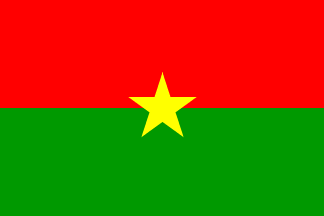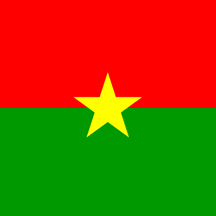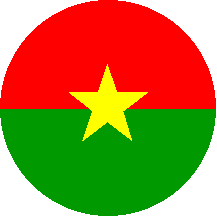Burkina Faso (original) (raw)

This page is part of © FOTW Flags Of The World website
Last modified: 2024-06-15 by ian macdonald
Keywords: [burkina faso](keywordb.html#burkina faso) | [star: 5 points (yellow)](keywords.html#star: 5 points %28yellow%29) |
Links: FOTW homepage |search | disclaimer and copyright | write us | mirrors
 image by António Martins, 27 May 2004
image by António Martins, 27 May 2004
- Origin of the flag
- Design details
- Efforts to raise flag awareness
- Presidential flag
- Other flags
- 1984 name change
- Coat of arms of Burkina Faso See also:
- Regional Councils
- Upper Volta (1959-1984)
- Military flags
- Educational institutions
- Air Burkina
- Red Cross
Origin of the flag
In August 1984 there was a coup and a new flag andemblem were adopted. The new flag, adopted 4 August 1984, is in the pan-African colours, reflecting both a break with the country’s colonial past and its unity with other African ex-colonies. The red is also said to symbolize the revolution and the green the abundance of natural riches. The yellow star placed over the red and green stripes is the guiding light of the revolution.
Ivan Sache, 26 December 1999, quoting from [rya97]
New flag I believe that was a personal decision of pro-soviet president Sankara, perhaps underVietcong inspiration (this is a personal observation). Flag was adopted 4 August 1984, first anniversary of the people’s democratic revolution (Sankara coup). According communication of the Comité de Defense de la Revolution to Lucien Philippe en August 1984, the red is the symbol of the revolutionary struggle, the green is for agriculture, abundance and hope; and yellow is for countries riches. Its five points symbolize the guidance of the revolution.
Jaume Ollé, 1 January 2000
Proposed meaning
The school teacher Rouamba Adama, from the primary school of Yandeguin in Koudougou, sent a plea for the Burkinabe national flag to the newspaper Sidwaya. The letter was published in 12 December 2004. After a description of the national flag, Adama gives the following meaning for the colours:
- red symbolizes the blood shed yesterday, today and tomorrow by the martyrs of the Revolution to ensure the victory. Moreover, red represents all the sacrifices of the Burkinabe people.
- green symbolizes the agricultural wealth of the country. Moreover, green symbolizes plenty, which shall ensure the happiness of the people.
- the yellow star is the ideological guide of the People’s and Democratric Revolution in its shining progress. Ivan Sache, 31 December 2004
Efforts to raise flag awareness
Colonel Mamadou Djerma, Grand Chancellor of the National Orders of Burkina Faso, wants each Brukinabe to hoist the national flag for the national day (11 December). Here are some extracts (my translation from French) of an interview he gave to Issa Soma and Jean-Philippe Tougouma, from the newspaper Sidwaya (full version here):
You released a communique asking the citizens to put a national flag on their door, roof, vehicle… What does it mean?
All Burkinabes shall know the meaning of the national flag. In the USA; for instance, for the national day, all doors, vehicles, houses are decorated with the flag. This means that they love their country. When you love your country, you should have your national flag.
I noticed that people do not know well the flag. That is why I released the communiqué, so that everybody knows that on the national day he should have the flag. […] In our country, the flag is hardly seen except during football matches. I was recently in a border city where the flag was hoisted, but I confirm that this was not the flag of Burkina Faso.
We released a decree requiring that the flag was raised in front of all government bodies (high commissionates, city halls, police, gendarmerie, ministries). Unfortunately, there are ministries where nobody is available to raise the flag. […] I released another decree prescribing the raising of the colours in the schools.
What will be done in the future to help the citizens to purchase a flag?
We can help but we will not give the flag for free. The flag shall be paid. I can pay the flag and give it to all citizens. I plan a training session for the tailors from the provinces so that they know the official dimensions, the cut, the size… of the flag. This would prevent people to manufacture themselves incorrect flags. I plan to ask the governors to send in 2005 a tailor from each region to the training session. Therefore, the flags could be made locally in the governorates rather than in Ouagadougou [the capital city].
Is there a link between your call and the National Week for Citizenship?
The authority of the state includes public-spiritedness. People shall respect the raising of the flag. It is an important, public-spirited act. The flag represents the Nation. I personally fought during the War of Indochina [in the French Army]. During the battle, when the flag bearer was hit by a bullet, a soldier jumped on him and took the flag. The flag shall never touch the ground […] The flag represents everything for a people. One should never have fun with the flag.
[The next paragraph does not seem to be correctly placed] We sent a decree to the local authorities. I plan funds for the purchase of flags. We have flags that are sold at lower price. We called the owners of the SOTRACO [transport company] so that they hoist on their buses pennants of the national flag (sic: fanions du drapeau national).
Ivan Sache, 31 Dec 2004
The school teacher Rouamba Adama, from the primary school of Yandeguin in Koudougou, sent a plea for the Burkinabe national flag to the newspaper Sidwaya. The letter was published in 12 December 2004. Adama regrets that such beautiful colours have so few admirers. Raising the flag is a reminiscence from the Revolution. However, thousands of school do not have an acceptable flag pole, whereas the prefectures have stopped the raising of the flag for years. The reason for this abandon of flag raising are:
- the price of the flag. At the Grand Chancelry, a satin flag costs 6,000 francs CFA whereas a cotton flag costs 2,000 francs CFA [see details]. However, the national cause is priceless. It is possible to find cheaper solutions, as can be seen during the football matches, when home-made flags cost c. 1,500 francs CFA. Such flags could fit a pedagogical use.
- the lack of an official law or decree prescribing the respect of the national flag in schools. This is mostly a lack of communication, since decrees concerning the national flag are sometimes forwarded to the schools. For instance, the decree 2004-54/Meba/DREBA-CO was forwarded by the Circumscription of Basic Education of Koudougou #2 in the province of Boulkiemde on 10 February 2004.
- the increasing lack of interest of young people for politics and the decrease of patriotism, which must be the true reason. Adama proposes the following solutions:
- a campaign «a school, a national flag»
- in the framework of the reestablishment of school uniform, the national emblem could be integrated to the new uniform. For instance, the upper third of the pocket could have the national colours.
It is suggested that the deputies and ministers organize the distribution of 50 national flags to each school of the country.
Ivan Sache, 31 Dec 2004
Presidential flag
 image by Zoltan Horvath, 27 April 2024
image by Zoltan Horvath, 27 April 2024
According to [pay00], it is square version of the national flag with a golden fringe around the three “free” edges.
Ivan Sache, 07 April 2001
I haven�t found any pictorial evidence of the square version of this flag, only an oblong version. And even then, it seems that president uses the national flag only, with fringe or without fringe.
Zoltan Horvath, 27 April 2024
Other flags
Burkina Faso has currently 30 provinces, an Army and an Air Force, so there might be other flags to track…
Ivan Sache, 26 December 1999
At the Ouagadougou Municipality website, all about the city’s new coat of arms, but no flag info. Since this would be the place to look for a municipal flag, and since that this is the capital city, I guess that we may assume that there are no official subnational flags in Burkina Faso.
António Martins, 23 November 2005
See also:
- Laws about levels and sutructure of local government in Burkina Faso
reported by António Martins, 23 Nov 2005
1984 name change
In 1984 the country became socialist and changed the name [from Upper Volta] to Burkina Faso and the flag to the current red over green with central yellow star.
Nick Artimovich, 05 June 1996
The meaning of Burkina Faso is "land of the incorruptibles", "land of the honourable men", I think in language_Morée_ — which is the language of the Mossi, the biggest burkinabe people.
Johannes Weigand, 27 February 1998
"Burkina Faso" is a combination of the Mossi ethnic group’s language, called More and the Bobo group’s Gur. This was an effort by then president Thomas Sankara to ensure continued harmony between these two groups.
David Bartlett, 14 February 2000
According to Fischers Weltalmanach 1985 (Frankfurt am Main, 1984), the state took first the french writing_Bourkina-Fasso_, from 4th to 15th of August, 1984, after they changed in Burkina Faso.
Johannes Weigand, 27 February 1998
Already from the 4th August 1984 onwards the official country’s name was "Burkina Faso". The short hand name should be "Burkina", but is rarely used. (sources: Letters and Press Releases by the Embassy of Burkina Faso, dated 11 August 1984 (reprinting an interview with Ouatamon Lamien, Director of the National Radio of Burkina Faso), 1985.07.05, 1985.12.26; Süddeutsche Zeitung, 1984.08.04-05, ibidem 1984.08.06, _ibidem_1985.12.28-29; Die Welt, 18 September 1984.)
Dieter Linde, 28 February 1998
Aircraft markings
 image by António Martins, 23 February 2005
image by António Martins, 23 February 2005
According to [pay00], the fuselage marking is a round version of the national flag. The national flag is painted on thefin.
Ivan Sache, 07 April 2001
Coat of arms of Burkina Faso

The description of Coat of Arms was published in the_Journal officiel du Burkina Faso_ Nr 38 of 18.09.97.
Armand du Payrat, 09 January 1998
Constitution (Article 34)
The emblem is the tricolor flag, rectangular and horizontal, red and green, with, centered, a yellow-gold, 5-pointed star. The law determines the arms and the meaning of their constitutive elements.
Law No 020/97/II/AN devoted to the description and meaning of the arms of Burkina Faso
National Assembly of Burkina Faso According to the Constitution; According to Resolution n° OO01/97/AN of 07 June 1997, validating the mandate of the deputees in Burkina Faso; Deliberated in its session of 1st August 1997, and adopted the following law:
Article 1:
The arms of Burkina Faso are constituted as follows: one (1) shield bearing in chief, on a silver scroll the name of the country "BURKINA FASO"; in the middle an escutcheon with two (2) stripes in fasce bearing the national emblem and "broching" on two (2) crossed lances; two (2) reared-up silver stallions supporting the escutcheon on each side; in the bottom an open book; below, two (2) millet stalks with three pairs of green, half-mooned, leaves, equidistant from the vertical line going through the points of the escutcheon and the upper branch of the star of the emblem. Stalks are crossed and linked at the basis by a flame bearing the national motto "Unity - Progress - Justice". The flame supports the whole "millet stalks - lances - escutcheon".
Article 2:
The two stallions symbolize the nobility of the burkinabe people; their position means action and their disposition the necessity and importance of the union that makes the force of the people. The escutcheon symbolizes the protection of the nation and the love of the country; shield against the hazards, rampart again all aggressions, he ensures the security of the state. The lances symbolize the determination of the sons of Burkina Faso to protect their country; their crossed design means vigilancy and bravery of this nation. The open book symbolizes the quest for knowledge and education, factors of progress and development. Millet spikes symbolize the will of food independence and abundance.
Article 3:
The present law will be reinforced as a law of the State. This was done and deliberated in public audience in Ouagadougou on 1st August 1997.
translated by Ivan Sache, 15 Apr 1999, from theofficial governmental site; see here the original text
This is one of those not really “eu-heraldic” emblems but which is just this close… Its shield bears a representation of the national flag, which in turn can be termed with no favour a heraldic design: per fess gules and vert an estoile or over all.
António Martins, 23 November 2005
Burkina Faso is one more to join the number of countries whose national flag has determined the national coat of arms, just like Iceland or the Dominican Republic. These flags not actual banners of arms because the flag appeared first, though from a synchronic point of view there is no difference — one needs to know the history of each flag and coat of arms.
António Martins, 23 November 2005
Blaise Campoare, the President of Burkina Faso, might have decided to modify the country emblem towards a less belliquous and Afro-marxist image (as well as he has progressively drifted from the strong Afro-marxist orientation given by his ex-brother-in-arms T. Sankara, who had made the 1984 coup). What is more stranger is that the new coat of arms re-uses some elements of the Upper-Volta coat of arms (the stallions, the crossed lances, the sorghum plants) shown in Smith [smi75b] and also the book which was present in the former arms but not in the Upper-Volta arms. The motto of Upper-Volta was then Unité - Travail - Justice and the new one is…Unité - Progrés - Justice! I think it is another very interesting case of re-use of ancient symbols after successive radical political changes.
Ivan Sache, 26 December 1999
Former coat of arms
The coat of arms shows a cog-wheel and a star to represent the revolution of 1984. Within the cog-wheel is a hoe representing agriculture, crossed with a Kalashnikov rifle symbolizing the willingness to defend the country and a book reflecting the importance of education. They are placed together to represent the alliance of workers, soldiers and intellectuals. Around the cog-wheel are sorghum plants. At the base is a scroll with the national motto — «La Patrie Ou La Mort — Nous Vaincrons» («Our country or death — We will conquer»).
Ivan Sache, 26 December 1999, quoting from [rya97]